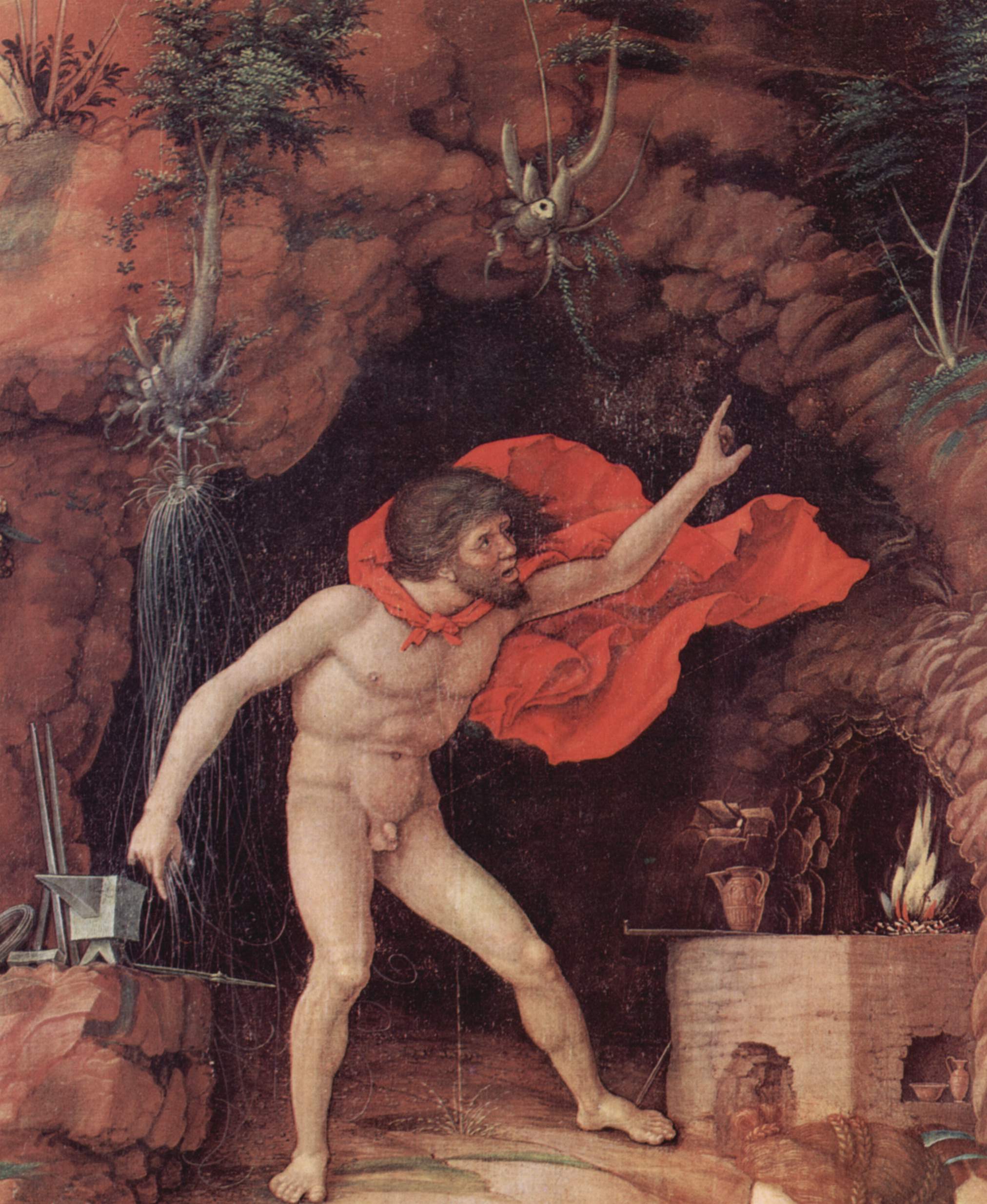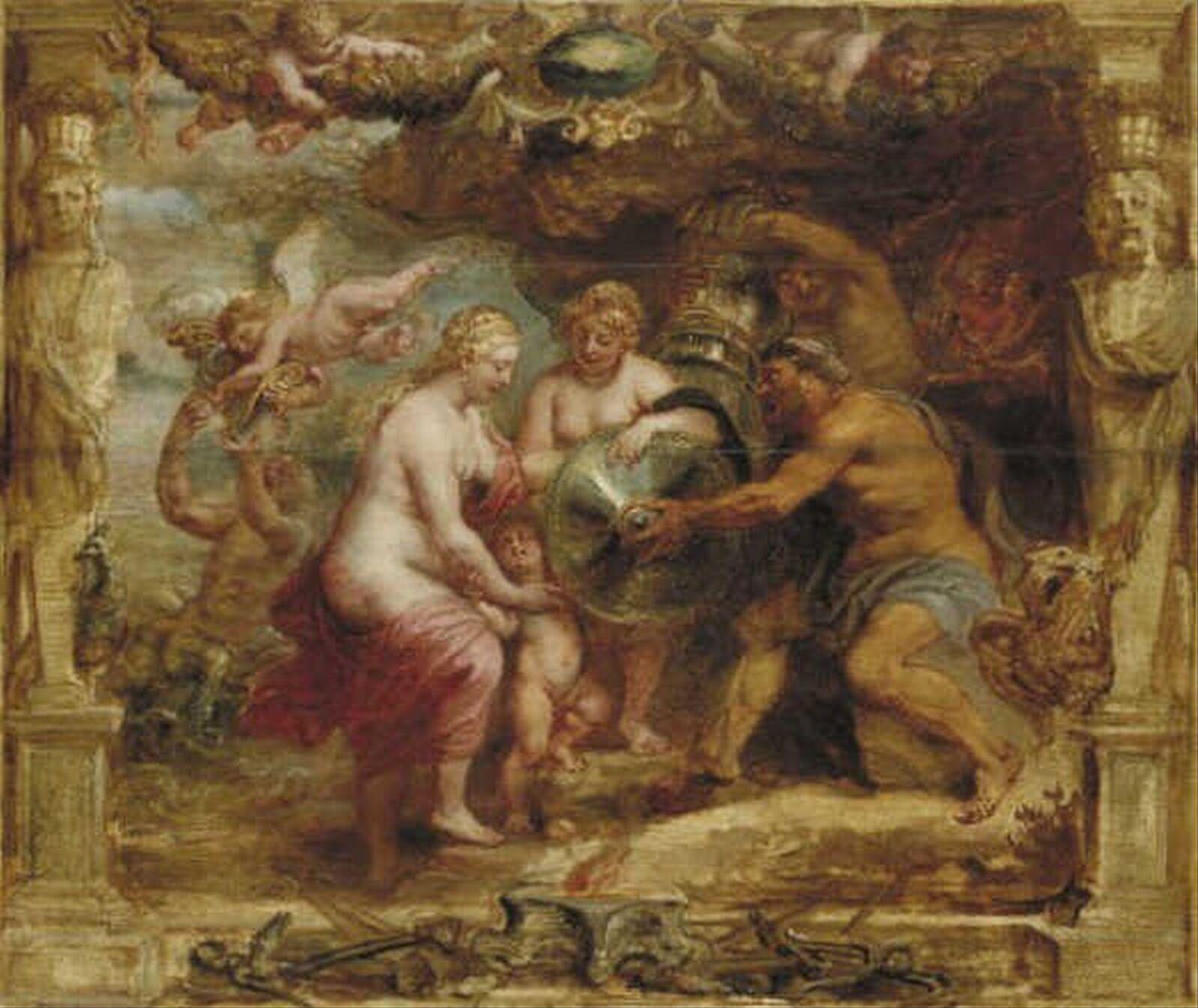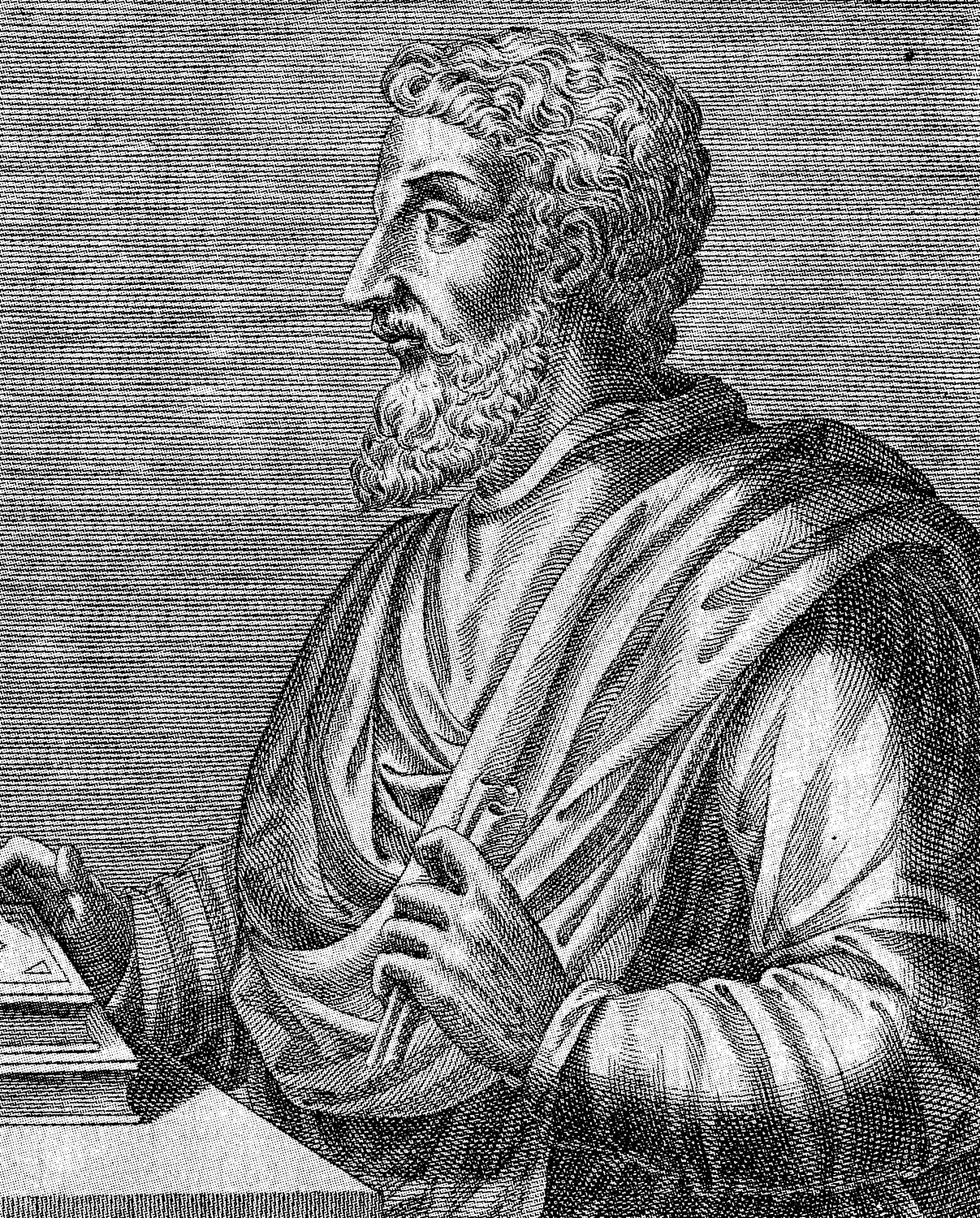|
Vulcanus
Vulcan (, in archaically retained spelling also ''Volcanus'', both pronounced ) is the god of fire including the fire of volcanoes, deserts, metalworking and the forge in ancient Roman religion and myth. He is often depicted with a blacksmith's hammer. The Vulcanalia was the annual festival held August 23 in his honor. His Greek counterpart is Hephaestus, the god of fire and smithery. In Etruscan religion, he is identified with Sethlans. Vulcan belongs to the most ancient stage of Roman religion: Varro, the ancient Roman scholar and writer, citing the Annales Maximi, records that king Titus Tatius dedicated altars to a series of deities including Vulcan. Etymology The origin of the name is unclear. Roman tradition maintained that it was related to Latin words connected to lightning (), which in turn was thought of as related to flames. This interpretation is supported by Walter William Skeat in his etymological dictionary as meaning ''lustre''. It has been supposed that hi ... [...More Info...] [...Related Items...] OR: [Wikipedia] [Google] [Baidu] |
Hephaestus
Hephaestus ( , ; wikt:Hephaestus#Alternative forms, eight spellings; ) is the Greek god of artisans, blacksmiths, carpenters, craftsmen, fire, metallurgy, metalworking, sculpture and volcanoes.Walter Burkert, ''Greek Religion'' 1985: III.2.ii; see coverage of Lemnos-based traditions and legends at Lemnos, Mythic Lemnos In Greek mythology, Hephaestus was the son of Hera, either on her own or by her husband Zeus. He was cast off Mount Olympus by his mother Hera because of his lameness, the result of a congenital impairment; or in another account, by Zeus for protecting Hera from his advances (in which case his lameness would have been the result of his fall rather than the reason for it). As a smithing god, Hephaestus made all the weapons of the gods in Olympus. He served as the blacksmith of the gods, and was worshipped in the manufacturing and industrial centres of Greece, particularly Athens. The cult of Hephaestus was based in Lemnos. Hephaestus's symbols are a smith's ham ... [...More Info...] [...Related Items...] OR: [Wikipedia] [Google] [Baidu] |
Jupiter (mythology)
Jupiter ( or , from Proto-Italic language, Proto-Italic "day, sky" + "father", thus "sky father" Greek: Zeus, Δίας or Zeus, Ζεύς), also known as Jove (nominative case, nom. and genitive case, gen. ), is the sky god, god of the sky and god of thunder, thunder, and king of the gods in ancient Roman religion and Roman mythology, mythology. Jupiter was the chief deity of Roman state religion throughout the Roman Republic, Republican and Roman Empire, Imperial eras, until Constantine the Great and Christianity, Christianity became the dominant religion of the Empire. In Roman mythology, he negotiates with Numa Pompilius, the second king of Rome, to establish principles of Roman religion such as offering, or sacrifice. Jupiter is thought to have originated as a sky god. His identifying implement is the thunderbolt and his primary sacred animal is the eagle, which held precedence over other birds in the taking of auspices and became one of the most common symbols of the Roma ... [...More Info...] [...Related Items...] OR: [Wikipedia] [Google] [Baidu] |
Mars (mythology)
In ancient Roman religion and Roman mythology, mythology, Mars (, ) is the god of war and also an Roman agriculture, agricultural guardian, a combination characteristic of early ancient Rome, Rome. He is the son of Jupiter (mythology), Jupiter and Juno (mythology), Juno, and was pre-eminent among the Religion in the Roman military, Roman army's military gods. Most of his Roman festivals, festivals were held in March, the month named for him (Martius (month), Latin ''Martius''), and in October, the months which traditionally began and ended the season for both military campaigning and farming. Under the Hellenization, influence of Greek culture, Mars was interpretatio graeca, identified with the Greek mythology, Greek god Ares,''Larousse Desk Reference Encyclopedia'', The Book People, Haydock, 1995, p. 215. whose myths were reinterpreted in Latin literature, Roman literature and Roman art, art under the name of Mars. The character and dignity of Mars differs in fundamental ways fr ... [...More Info...] [...Related Items...] OR: [Wikipedia] [Google] [Baidu] |
Dii Consentes
The ''Dii Consentes'', also known as ''Di'' or ''Dei Consentes'' (once ''Dii Complices''), or ''The Harmonious Gods'', is an ancient list of twelve major deities, six gods and six goddesses, in the pantheon of Ancient Rome. Their gilt statues stood in the Roman Forum, and later apparently in the Porticus Deorum Consentium. The gods were listed by the poet Ennius in the late 3rd century BCE in a paraphrase of an unknown Greek poet: Livy arranges them in six male-female pairs: Jupiter-Juno, Neptune-Minerva, Mars-Venus, Apollo-Diana, Vulcan-Vesta and Mercury-Ceres. Three of the ''Dii Consentes'' formed the Capitoline Triad: Jupiter, Juno and Minerva. Precursor lists The grouping of twelve deities has origins older than the Greek or Roman sources. Hittite The Greek grouping may have Hittite origins via Lycia, in Anatolia. A group of twelve Hittite gods is known both from cuneiform texts and from artistic representation. All the Hittite Twelve are male, with no indi ... [...More Info...] [...Related Items...] OR: [Wikipedia] [Google] [Baidu] |
Titus Tatius
According to the Roman foundation myth, Titus Tatius, also called Tatius Sabinus, was king of the Sabines from Cures and joint-ruler of the Kingdom of Rome for several years. During the reign of Romulus, the first king of Rome, Tatius declared war on Rome in response to the incident known as The Rape of the Sabine Women. After he captured the stronghold atop the Capitoline Hill through the treachery of Tarpeia, the Sabines and Romans fought an epic battle that concluded when the abducted Sabine women intervened to convince the two sides to reconcile and end the war. The two kingdoms were joined and the two kings ruled jointly until Tatius' murder five years later.Livy, ''Ab Urbe Condita'', i. 9-14. The joint kingdom was still called Rome and the citizens of the city were still called Romans, but as a community, they were to be called '' Quirites''. The Sabines were integrated into the existing tribes and curies, yet Tatius is not counted as one of the traditional "Seven ... [...More Info...] [...Related Items...] OR: [Wikipedia] [Google] [Baidu] |
Latin
Latin ( or ) is a classical language belonging to the Italic languages, Italic branch of the Indo-European languages. Latin was originally spoken by the Latins (Italic tribe), Latins in Latium (now known as Lazio), the lower Tiber area around Rome, Italy. Through the expansion of the Roman Republic, it became the dominant language in the Italian Peninsula and subsequently throughout the Roman Empire. It has greatly influenced many languages, Latin influence in English, including English, having contributed List of Latin words with English derivatives, many words to the English lexicon, particularly after the Christianity in Anglo-Saxon England, Christianization of the Anglo-Saxons and the Norman Conquest. Latin Root (linguistics), roots appear frequently in the technical vocabulary used by fields such as theology, List of Latin and Greek words commonly used in systematic names, the sciences, List of medical roots, suffixes and prefixes, medicine, and List of Latin legal terms ... [...More Info...] [...Related Items...] OR: [Wikipedia] [Google] [Baidu] |
Varro
Marcus Terentius Varro (116–27 BCE) was a Roman polymath and a prolific author. He is regarded as ancient Rome's greatest scholar, and was described by Petrarch as "the third great light of Rome" (after Virgil and Cicero). He is sometimes called Varro Reatinus ("Varro of Rieti") to distinguish him from his younger contemporary Varro Atacinus ("Varro of Aude (river), Atax"). Biography Varro was born in or near Reate (now Rieti in Lazio) into a family thought to be of Equites, equestrian rank. He always remained close to his roots in the area, owning a large farm in the Reatine plain (reported as near Lago di Ripasottile,) until his old age. He supported Pompey, reaching the office of praetor, after having served as tribune of the plebs, tribune of the people, ''quaestor'' and ''curule aedile''. It is probable that Varro was discontented with the course on which Pompey entered when the First Triumvirate formed 60 BC, and he may thus have lost his chance of rising to the c ... [...More Info...] [...Related Items...] OR: [Wikipedia] [Google] [Baidu] |
God Of Fire
This is a list of deities in fire worship. African mythology Bantu mythology * Nyambe, god of the sun, fire and change * Nzambia, NZambi, Zambia a Kikongo Mpungu, Nzambi Mpungu, 1st half or other side of God, considered the Chief Creation Deity in Palo Mayombe and it’s various branches also known as Ramas in the Marawa dialect. * Lukankazi, Lungambe, Kadiempembe, a Kikongo Mpungu, Lukankazi Mpungu, the other half or opposite side of God, considered the Chief Destruction Deity in Palo Mayombe and it’s various branches also known as Ramas in the Marawa dialect. Egyptian mythology * Ra, fire god of the sun, light, warmth, and growth * Sekhmet, protective lioness goddess of war, along with some elements of disease and curing of disease. Sometimes referenced in relation to the sun and its power, so possibly had to do with upkeep of the sun at times and fire * Wadjet, the protective serpent goddess who sends fire to burn her enemies Yoruba mythology * Ogun, fire god and ... [...More Info...] [...Related Items...] OR: [Wikipedia] [Google] [Baidu] |
Etruscan Religion
Etruscan religion comprises a set of stories, beliefs, and religious practices of the Etruscan civilization, heavily influenced by the mythology of ancient Greece, and sharing similarities with concurrent Roman mythology and Religion in ancient Rome, religion. As the Etruscan civilization was gradually assimilated into the Roman Republic from the 4th century BC, the Etruscan religion and mythology were partially incorporated into ancient Roman culture, following the Roman tendency to absorb some of the local gods and customs of conquered lands. The first attestations of an Etruscan religion can be traced back to the Villanovan culture. History Greek influence Greek traders brought their religion and hero figures with them to the coastal areas of the central Mediterranean. Odysseus, Menelaus and Diomedes from the Homeric tradition were recast in tales of the distant past that had them roaming the lands West of Greece. In Greek tradition, Heracles wandered these western areas, ... [...More Info...] [...Related Items...] OR: [Wikipedia] [Google] [Baidu] |
Interpretatio Graeca
, or "interpretation by means of Greek [models]", refers to the tendency of the ancient Greeks to identify foreign deities with their own gods. It is a discourse used to interpret or attempt to understand the mythology and religion of other cultures; a Comparative religion, comparative methodology using Religion in ancient Greece, ancient Greek religious concepts and practices, List of Greek deities, deities, and Greek mythology, myths, Comparative mythology, equivalencies, and shared characteristics. The phrase may describe Greek efforts to explain others' beliefs and myths, as when Herodotus describes ancient Egyptian religion, Egyptian religion in terms of perceived Greek analogues, or when Dionysius of Halicarnassus and Plutarch document Cult (religious practice), Roman cults, Roman temple, temples, and practices under the names of equivalent Greek deities. may also describe non-Greeks' interpretation of their own belief systems by comparison or assimilation with Greek model ... [...More Info...] [...Related Items...] OR: [Wikipedia] [Google] [Baidu] |
Roman Festival
Festivals in ancient Rome were a very important part of Roman religious life during both the Republican and Imperial eras, and one of the primary features of the Roman calendar. ''Feriae'' ("holidays" in the sense of "holy days"; singular also ''feriae'' or ''dies ferialis'') were either public ''(publicae)'' or private ''( privatae)''. State holidays were celebrated by the Roman people and received public funding. Games ''( ludi)'', such as the Ludi Apollinares, were not technically ''feriae'', but the days on which they were celebrated were '' dies festi'', holidays in the modern sense of days off work. Although ''feriae'' were paid for by the state, ''ludi'' were often funded by wealthy individuals. ''Feriae privatae'' were holidays celebrated in honor of private individuals or by families. This article deals only with public holidays, including rites celebrated by the state priests of Rome at temples, as well as celebrations by neighborhoods, families, and friends held ... [...More Info...] [...Related Items...] OR: [Wikipedia] [Google] [Baidu] |









